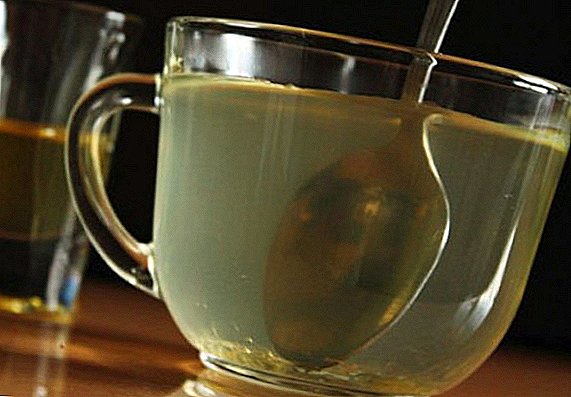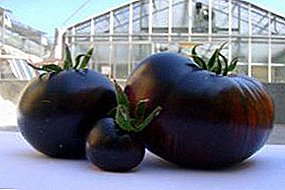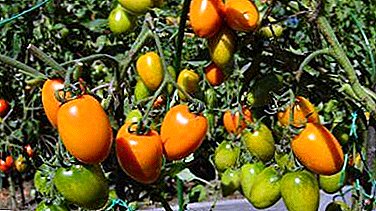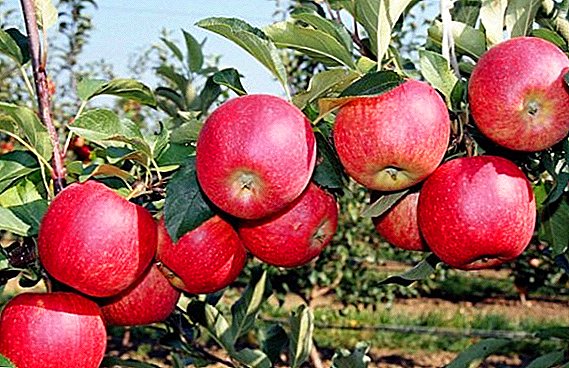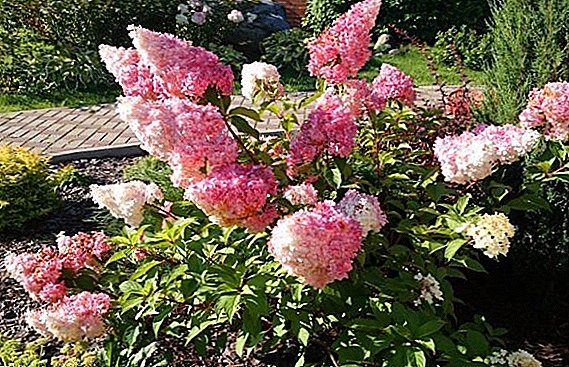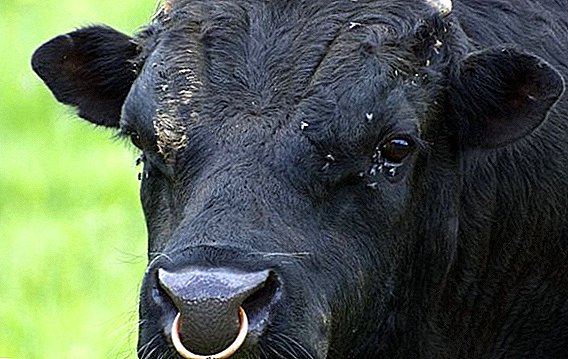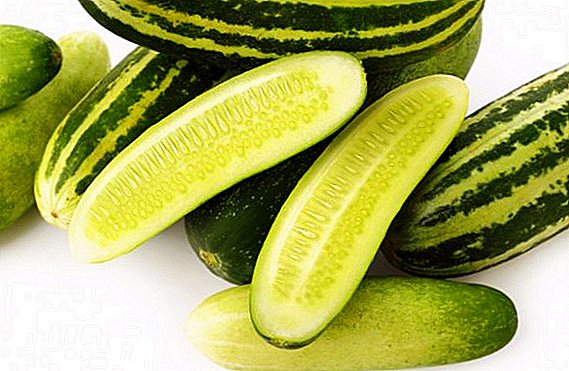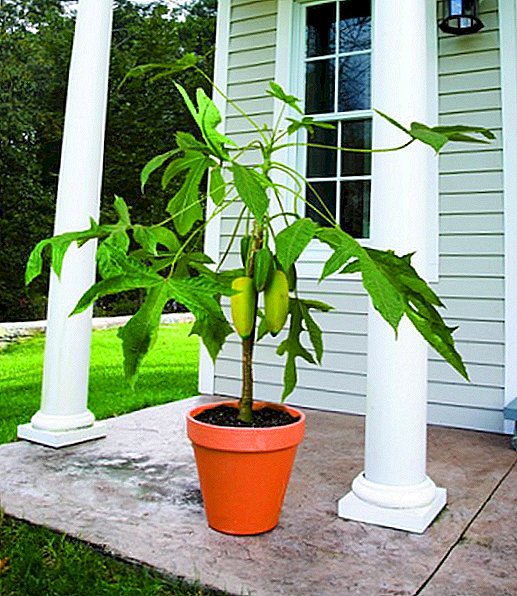 Exotic plants at home are no longer a wonder, but they still delight the eye with their singularity and bright tropical greenery. Papaya is one of these plants, in appearance it resembles a palm tree with wide and long leaves. In nature, its height reaches 10 meters, at home - up to 6 meters in height.
Exotic plants at home are no longer a wonder, but they still delight the eye with their singularity and bright tropical greenery. Papaya is one of these plants, in appearance it resembles a palm tree with wide and long leaves. In nature, its height reaches 10 meters, at home - up to 6 meters in height.
Growing papaya seed
Melon papaya tree becomes a popular home plant, it adorns the rooms and closed terraces or heated balconies and verandas. This tree is quite capricious, therefore care for it and growing conditions must be strictly and consistently followed.

Requirements for planting material
The main requirement for growing papaya from the stone is fresh fruit seed. The fruit is cut, remove the seeds, washed with clean water. For about a day, the bones need to be dried, then discarded the damaged ones.
Seed preparation
Landing preparation can be made. two ways:
- The first is to place the material in wet sand (moss) for 12 hours and cover with a film;
- The second is to soak in a growth stimulator for the same time.
Optimum terms for landing
Planting seeds is carried out in March. At this time, the light day begins to increase, and the plant receives the required amount of light. When sowing in another season, it is necessary to provide additional coverage.
Important! With a lack of lighting, the tree is strongly drawn out, it does not develop properly, the leaves and stems turn yellow, they turn.

Soil and planting capacity
Before planting papaya, a suitable soil mixture is also prepared: to do this, mix leaf and sod soil, sand and peat in equal proportions. If it is not possible to prepare the soil on your own, the purchased soil for ficuses, supplemented with sand, will be suitable. As a container, you can take a long container, on the bottom of which a drainage is placed, for example, fine expanded clay or pebbles.
Also grow other exotic plants: lychee, jujube, pineapple, cucumber-lemon, kumquat, loquat.
Sowing seeds
For sowing take a large number of seeds to be able to choose the strongest seedlings. They are planted at a centimeter distance from each other to a depth of 2 cm. After processing, the germination percentage should be high, sprouts appear in 12-15 days.
Sprouting conditions
Papaya is a resident of the tropics, so to understand how to grow it from seeds at home is easy, enough to provide heat, light and moisture. The container with crops is covered with glass, thereby creating a greenhouse effect. Be sure to air crops for about an hour every day, removing the glass. Emerged shoots are seated in separate pots.

Seedling care
Shoots watered regularly, but in small doses, so as not to provoke root rot. It is also important to prevent the soil from drying out. A young plant needs light, if there is a lack of it, additional artificial lighting is provided.
Further care and conditions for growing papaya at home
Papaya is the birthplace of southern Mexico, the tree is also grown in North and Central America. In the northern latitudes on open ground, the plant can not live, so it is grown only as a room decoration.

Lighting
The tree needs to be provided as much light as possiblepreferably solar. If this is not possible, fluorescent lamps can be used.
Important! The distance between the leaves and the lamp must be at least 30 cm, otherwise the plant will get burned.A tree always stretches to the light, for uniform growth it must be periodically rotated on different sides. In summer, adult trees are determined on the balcony, gradually hardening them.
Temperature conditions
As already mentioned, the culture is tropical and needs constant warmth, the optimum temperature of + 18 ... + 24 ° C. air (balcony, loggia, porch).
Watering and moisture
Papaya has large leaves, from such a surface moisture evaporates quickly and in large volumes, because of which watering is needed daily. To maintain high humidity, spraying is carried out. Excess moisture is highly undesirable, so papaya at home in a pot should have good drainage and drain pan for excess moisture. In cool weather, watering is carried out a little less.

Top dressing
The plant begins to feed two weeks after the first transplant. Make a complex of mineral dressings with an interval of once every two weeks, according to the instructions for the fertilizer. The tree responds well to organic compounds: humus and manure. During flowering need phosphorus-potassium fertilizer, and for growth - nitrogen. Do not forget about the mulch, the ideal option would be shredded grass, through which you get an imitation of flooring in the rainforest.
Transfer
 In young specimens, roots grow rapidly, filling the entire container. A transplant is needed every year so that growth does not slow down. Here it is necessary to remember the extreme fragility of the root system of a plant; even minor damage to it will lead to death. Without transplantation growth will slow down, there will be no flowering, you can forget about fruiting. Each new container during transplantation is 8-10 cm larger than the previous one.
In young specimens, roots grow rapidly, filling the entire container. A transplant is needed every year so that growth does not slow down. Here it is necessary to remember the extreme fragility of the root system of a plant; even minor damage to it will lead to death. Without transplantation growth will slow down, there will be no flowering, you can forget about fruiting. Each new container during transplantation is 8-10 cm larger than the previous one.
Important! Large pot is contraindicated, because the roots do not have time to cover the soil clod, and when watering there is a danger of root rot. Large capacity is suitable for a strong and developed root cuttings.
Reproduction papaya cuttings
How to grow papaya house cuttings? For this purpose, cuttings of plants of one or two years old are 1.5 cm thick. They are cut to a length of 10 cm, cutting off almost all the leaves, dried for about three days: they should not have a lot of juice, and the cut place will be overgrown during this time and bacteria.
Then rooting is planted in a container with large wet sand or peat, planting depth of about 3 cm. Cover the cutting with a plastic bottle cut, rooting will not occur without a greenhouse effect. The first transplant is carried out in a container 2-3 cm more than the previous one.
In the future, care is no different from the conditions of detention of an adult specimen.
With the help of cuttings also propagated: thuja, grapes, plum, laurel, chrysanthemum, petunia, clematis, Brugmania, plumeria.
What diseases and pests threaten?
Papayas, when grown at home, are prone to few pests and diseases, but they can also severely damage a tree. The spider mite and aphid are dangerous because they suck the sap of the plant, destroying the foliage and stalks, leaving their offspring. To combat them, drugs of acaricidal action insecticides, such as "Aktellik", "Antiklesch", biological - "Akarin" and "Fitoverm" are used. Of the popular methods help spraying soapy water, decoctions of yarrow or garlic.

The most common disease is powdery mildew, the causes - high humidity or coolness. Prevention will serve strict temperature content, control irrigation (the same applies to root rot). To combat the powdery mildew, which manifests itself in the form of white scurf, it is most effective with the help of copper sulfate or colloidal sulfur. The fungicide preparations “Hom”, “Kuprozan”, “Vitaros” help to overcome the disease. Folk methods of struggle: soap-soda solution, ash solution, weak pink solution of potassium permanganate and decoction of onion or garlic.
Did you know? On the set of one of the "Indiana Jones" parts, Harrison Ford conducted treatment of intervertebral hernia with papain injections. This miracle of the tropics is an effective regenerating and healing agent.
Does papaya produce at home?
 Fruiting papaya at home is a controversial issue: according to some data, the fruits fall, not having time to ripen, according to other reviews successfully ripen. Plant growers, who are fortunate enough to eat the fruits of their plants, insist on the ideal conditions of care and maintenance, then the desired becomes possible. The first flowering occurs after 10-11 months from planting, and after, naturally, fruits appear.
Fruiting papaya at home is a controversial issue: according to some data, the fruits fall, not having time to ripen, according to other reviews successfully ripen. Plant growers, who are fortunate enough to eat the fruits of their plants, insist on the ideal conditions of care and maintenance, then the desired becomes possible. The first flowering occurs after 10-11 months from planting, and after, naturally, fruits appear.
Did you know? The Indians of America used fruit juice to soften old or hard meat. No less interesting is that with prolonged and regular contact with juice, fingerprints are gradually erased.Papayas are loved for its beneficial properties, used as a dietary product, vitamin, and as a preventive measure against some diseases, for example, flu and cold. Fruits and juice are used in cosmetology, as part of skin care products for the face, neck and hands, and for hair.


